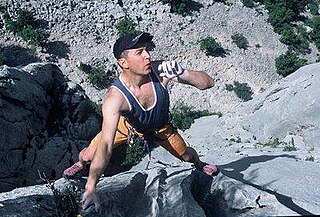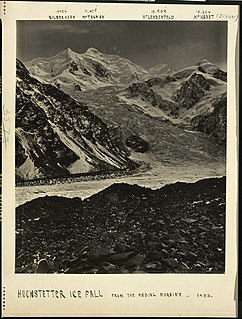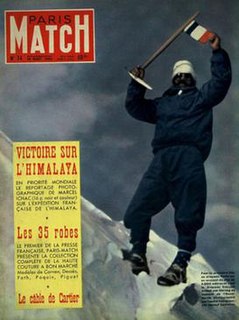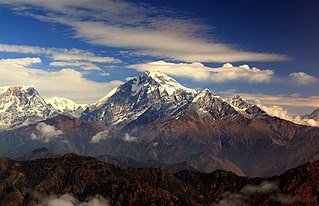
The International Mountaineering and Climbing Federation (UIAA) recognises eight-thousanders as the 14 mountains that are more than 8,000 metres (26,247 ft) in height above sea level, and are considered to be sufficiently independent from neighbouring peaks. However, there is no precise definition of the criteria used to assess independence, and, since 2012, the UIAA has been involved in a process to consider whether the list should be expanded to 20 mountains. All eight-thousanders are located in the Himalayan and Karakoram mountain ranges in Asia, and their summits are in the death zone.

Dhaulagiri is the seventh highest mountain in the world at 8,167 metres (26,795 ft) above sea level, and the highest mountain within the borders of a single country (Nepal). It was first climbed on 13 May 1960 by a Swiss/Austrian/Nepali expedition. Annapurna I is 34 km (21 mi) east of Dhaulagiri. The Kali Gandaki River flows between the two in the Kaligandaki Gorge, said to be the world's deepest. The town of Pokhara is south of the Annapurnas, an important regional center and the gateway for climbers and trekkers visiting both ranges as well as a tourist destination in its own right.

Tomaž Humar, nicknamed Gozdni Joža, was a Slovenian mountaineer. A father of two, Humar lived in Kamnik, Slovenia. He completed over 1500 ascents, and won a number of mountaineering and other awards, including the Piolet d'Or in 1996 for his Ama Dablam ascent.
Lieutenant Colonel James Owen Merion Roberts MVO MBE MC was one of the greatest Himalayan mountaineer-explorers of the twentieth century; a highly decorated British Army officer who achieved his greatest renown as "the father of trekking" in Nepal. His exploratory activities are comparable to those of Eric Shipton and Bill Tilman.

Annapurna South is a mountain in the Annapurna Himal range of the Himalayas located in Nepal, and the 101st-highest mountain in the world. It is the 5th highest peak of the Annapurna mountain range. It was first ascended in 1964, and is 7,219 metres (23,684 ft) tall. The nearby mountain Hiunchuli is in fact an extension of Annapurna South.

Lendenfeld Peak, in the past also Mount Lendenfeld, is the eighth highest named summit in New Zealand and in Aoraki / Mount Cook National Park.
Wojciech Kurtyka is a Polish mountaineer and rock climber, one of the pioneers of the alpine style of climbing the biggest walls in the Greater Ranges. He lived in Wrocław up to 1974 when he moved to Kraków. He graduated as engineer in electronics. In 1985 he climbed the "Shining Wall" Gasherbrum IV, which Climbing magazine declared to be the greatest achievement of mountaineering in the twentieth century. In 2016, he received the Piolet d'Or for lifetime achievement in mountaineering.

Artur Henryk Hajzer was a Polish mountaineer. Hajzer climbed seven eight-thousanders, several via new routes and made the first winter climb of Annapurna on February 3, 1987. He also summited Annapurna East (8010m) via a new route up the SE face in 1988. All these climbs were done together with Jerzy Kukuczka, without supplemental oxygen or Sherpa support. Artur also attempted Lhotse South Face three times, reaching 8200 m in 1985, 8300 m in 1987 and 7200 m in 1989. He also organised a rescue operation on Mount Everest’s West Ridge for Andrzej Marciniak in 1989. On September 30, 2011, he summited Makalu with Adam Bielecki and Tomasz Wolfart. In July 2013 he died after falling in the Japanese Coloir after an attempt to reach the summit of Gasherbrum I.

The alpine pika is a species of small mammal in the pika family, Ochotonidae. The summer pelage of different subspecies varies drastically but, in general, it is dark or cinnamon brown, turning to grey with a yellowish tinge during the winter. The alpine pika is found in western Mongolia, eastern Kazakhstan, and Russia, as well as in China, in very cold, mountainous regions. It is a generalist herbivore, and mainly forages on mosses, tree branches, pine nuts, and plant stems. It can emit three series of different vocalizations: a long call, a short call, and an alarm call. It is rated as a species of least concern on the IUCN Red List of Endangered Species.
Michael Dacher was a German mountaineer and extreme climber. In 1979 he and Reinhold Messner climbed the K2 in record time and without oxygen equipment.
John Roskelley is an American mountain climber and author from Spokane, Washington. He made first ascents and notable ascents of 7,000-meter and 8,000-meter peaks in Nepal, India, and Pakistan.

Orites revolutus , also known as narrow-leaf orites, is a Tasmanian endemic plant species in the family Proteaceae. Scottish botanist Robert Brown formally described the species in Transactions of the Linnean Society of London in 1810 from a specimen collected at Lake St Clair. Abundant in alpine and subalpine heath, it is a small to medium shrub 0.5 to 1.5 m tall, with relatively small, blunt leaves with strongly revolute margins. The white flowers grow on terminal spikes during summer. Being proteaceaous, O. revolutus is likely to provide a substantial food source for nectivorous animal species within its range.
Nawang Dorje Sherpa, is a Nepalese mountaineer and mountain guide, best known for the first ascent of Dhaulagiri, as a member of Helvetic-Austrian expedition and many ascents in the mountains of the Himalaya Range.

Valery Nikolaevich Khrichtchatyi was a Kazakh mountaineer. He made more than forty ascents above 7,000 meters, including a string of hard winter firsts in the Pamirs and Tien Shan. He climbed Everest by a new south pillar route, Kanchenjunga without oxygen and with only one bivouac, and a new route on the west side of Dhaulagiri.

The 1950 French Annapurna expedition, led by Maurice Herzog, reached the summit of Annapurna I at 8,091 metres (26,545 ft), the highest peak in the Annapurna Massif. The mountain is in Nepal and the government had given permission for the expedition, the first time it had permitted mountaineering in over a century. After failing to climb Dhaulagiri I at 8,167 metres (26,795 ft), the higher peak nearby to the west, the team attempted Annapurna with Herzog and Louis Lachenal, reaching the summit on 3 June 1950. It was only with considerable help from their team that they were able to return alive, though with severe injuries following frostbite.

Eastern Rukum is a mountain district of Lumbini Province of Nepal situated along the Dhaulagiri mountain range. It is also the only mountain district of the province with its tallest mountain Putha Hiunchuli situated in the west end of Dhaulagiri II mountain chain, at an elevation of 7,246 meters. The drainage source of ancient Airavati river, one of the five sacred rivers of Buddhism, lies in the lesser Himalayas of the district. With a Dhaulagiri mountain range, lakes, rich Magar culture and its political history, Eastern Rukum has been among the top travel destinations of Nepal as designated by the Government of Nepal.

George Henry Lowe III is an American rock climber and alpinist, noted for his history of alpine-style mountaineering on difficult and infrequently repeated routes and his development of traditional climbing routes in the Western United States. He pioneered winter ascents in the North American Rockies along with cousins Jeff Lowe (climber), Mike Lowe, and Greg Lowe. He is also known for his technically difficult ascents of mixed climbing faces in the Himalayas including the unclimbed North Ridge of Latok I and the first ascent of the East Face of Mount Everest, where the Lowe Buttress bears his name. Lowe is currently a resident of Colorado.

The Dhaulagiri massif in Nepal extends 120 km (70 mi) from the Kaligandaki River west to the Bheri. This massif is bounded on the north and southwest by tributaries of the Bheri River and on the southeast by the Myagdi Khola.














